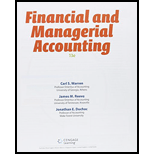
Concept explainers
1.
Adjusting entries refers to the entries that are made at the end of an accounting period in accordance with revenue recognition principle, and expenses recognition principle. All adjusting entries affect at least one income statement account (revenue or expense), and one
Rules of Debit and Credit:
Following rules are followed for debiting and crediting different accounts while they occur in business transactions:
- Debit, all increase in assets, expenses and dividends, all decrease in liabilities, revenues and
stockholders’ equities . - Credit, all increase in liabilities, revenues, and stockholders’ equities, all decrease in assets, expenses.
Accrual basis of accounting:
Accrual basis of accounting refers to recognizing the financial transactions during the period in which the event occurs, even if the cash is not exchanged.
Income statement:
This is the financial statement of a company which shows all the revenues earned and expenses incurred by the company over a period of time.
Balance sheet:
This is the financial statement of a company which shows the grouping of similar assets and liabilities under subheadings.
To prepare: The adjusting entries in the books of Company AC at the end of the year.
2.
The effects on the income statement, if adjusting entries are not recorded.
3.
The effects on the balance sheet, if adjusting entries are not recorded.
4.
The effects on the “net increase or decrease in cash” on the statement of cash flow , if adjusting entries are not recorded.
Trending nowThis is a popular solution!

Chapter 3 Solutions
Bundle: Financial & Managerial Accounting, Loose-Leaf Version, 13th + CengageNOWv2, 2 terms Printed Access Card
- Hillwood Textiles computes its plantwide predetermined overhead rate annually based on direct labor hours. At the beginning of the year, it was estimated that 42,000 direct labor hours would be required for the period's estimated level of production. The company also estimated $525,000 of fixed manufacturing overhead cost for the coming period and variable manufacturing overhead of $3.00 per direct labor hour. Hillwood’s actual manufacturing overhead cost for the year was $670,000, and its actual total direct labor hours were 43,200. Compute the company’s plantwide predetermined overhead rate for the year.arrow_forwardAccurate Answerarrow_forwardElizabeth Appliance Company had a net income of $68,400 and net sales of $480,000. Compute the relationship of net income to net sales.arrow_forward
- Using the weighted-average valuation method the equivalent units produced by the department were _________Units.arrow_forwardI am looking for the correct answer to this general accounting question with appropriate explanations.arrow_forwardPlease help me solve this general accounting question using the right accounting principles.arrow_forward
 Cornerstones of Financial AccountingAccountingISBN:9781337690881Author:Jay Rich, Jeff JonesPublisher:Cengage Learning
Cornerstones of Financial AccountingAccountingISBN:9781337690881Author:Jay Rich, Jeff JonesPublisher:Cengage Learning Intermediate Accounting: Reporting And AnalysisAccountingISBN:9781337788281Author:James M. Wahlen, Jefferson P. Jones, Donald PagachPublisher:Cengage LearningCentury 21 Accounting Multicolumn JournalAccountingISBN:9781337679503Author:GilbertsonPublisher:Cengage
Intermediate Accounting: Reporting And AnalysisAccountingISBN:9781337788281Author:James M. Wahlen, Jefferson P. Jones, Donald PagachPublisher:Cengage LearningCentury 21 Accounting Multicolumn JournalAccountingISBN:9781337679503Author:GilbertsonPublisher:Cengage



